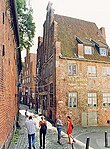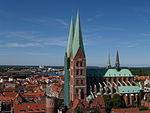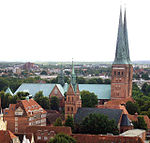St Peter's Church, Lübeck

St. Peter's Church (Deutsch: St. Petri zu Lübeck) is a place of worship in Lübeck, Germany, that was first mentioned in 1170. Over the centuries, it was rebuilt several times until construction of the church was completed in the 15th century. During the Second World War, St. Petri suffered severe damage and the restoration was not completed until 1987. Since the furnishings could not be restored, only special services take place in the church. As a city church without a congregation, it is mainly used for cultural and religious events as well as art exhibitions. The effect of the simple space of the five-aisled hall church is very well emphasized by the special architecture. Modern works of art such as the altar cross by the Austrian artist Arnulf Rainer and the illuminated neon cross by Hanna Jäger invite visitors to think.
Excerpt from the Wikipedia article St Peter's Church, Lübeck (License: CC BY-SA 3.0, Authors, Images).St Peter's Church, Lübeck
Petrikirchhof, Lübeck Innenstadt (Innenstadt)
Geographical coordinates (GPS) Address Website External links Nearby Places Show on map
Geographical coordinates (GPS)
| Latitude | Longitude |
|---|---|
| N 53.8658 ° | E 10.6833 ° |
Address
St.-Petri Kultur- und Universitätskirche
Petrikirchhof 1
23552 Lübeck, Innenstadt (Innenstadt)
Schleswig-Holstein, Germany
Open on Google Maps










